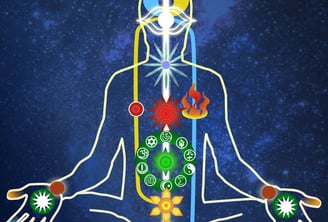The Essence of Chakras.
Chakras, as we have previously established, do not have a physical presence in the material world. Instead, they represent energy centers that are manifested within our etheric body. The idea of chakras originates from tantric texts, which depict these energy centers with a specific number of lotus petals associated with each one, reflecting their presence in the etheric realm...........Read More


Chakras, as we have previously established, do not have a physical presence in the material world. They are essentially energy centers that manifest within our etheric body. The idea of chakras originates from tantric texts, which describe them as having a specific number of lotus petals. For instance, the Muladhara chakra features four petals, the Swadhisthana has six, Manipura has ten, Anahata has twelve, Vishuddha has sixteen, and Ajna has two, totaling fifty petals. It is also important to note that these chakras are located at points where fine nerves intersect, creating a web-like structure. Our focused attention on these areas causes the chakras to radiate energy. Each chakra is associated with different colors that reflect the dominant qualities of that energy center. Generally, the brighter the colors, the lower the quality of energy. For example, the Muladhara chakra is linked to the red color, and Swadhisthana to orange, both of which correspond to Tamo guna, the lowest of the three gunas. The energy of Kundalini can be experienced across all three bodies: the causal body (karana sharira), the subtle body (sukshma sharira), and the gross body (sthula sharira), as well as through the five sheaths (koshas). This realization stems from the power of Kundalini. There are numerous instances where a person's energy can be sensed from a distance. When you cultivate love for humanity, your Anahata chakra expands, and a fully activated Anahata chakra draws people towards you, attracting love in return. I have chosen not to delve into the details of the chakras with lotus petals and Sanskrit letters, as that would require extensive theoretical discussion. However, it is essential to understand that with dedicated practice, you can perceive each chakra. Through consistent effort, you will develop the ability to see beyond the ordinary. Ultimately, mastery of Kundalini comes through practice.
The mind's power is the key element, as it interacts with all three types of bodies and the five sheaths. Supportive practices such as mula bandha, stretching, and breathing exercises simply facilitate the mind's work. Incorrect application of bandhas and breathing techniques can lead to negative outcomes. This is why having a master present is crucial, primarily to supervise physical practices. There are various opinions regarding chakras, but we won't delve into those details since we are not experts. However, one fact remains clear: the experience of kundalini varies significantly from individual to individual. Your experience with a chakra's expansion is unique to you, just as your clairvoyant perceptions differ from mine. Therefore, referencing someone else's experience holds little value. While the methods may be consistent, the outcomes are distinct. You may perceive the chakras as rotating due to the energy they produce, akin to a storm's eye seen in satellite imagery. The energy of a chakra spins around an axis, which is why we sense this rotation in our bodies, with the spinal cord serving as that axis.
